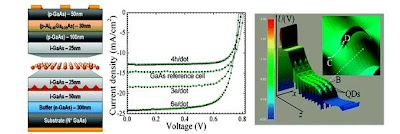Improving the efficiency of solar cells is a matter that must be done by scientists, so that electric power generated can be increased. Various ways have been done, such as creating multi-potential wells, take advantage of carbon nanotubes, and even embed nanoscale materials. An effort that is quite impressive is the research conducted by University at Buffalo, Army Research Laboratory and the Air Force Office of Scientific Research has developed a new technology based on nanoscale materials, managed to increase the efficiency of solar cells up to 45 percent.
 |
| Left: Structure of solar cell. Center and right is solar cell performance (acs.org) |
They embed the charged quantum dot material into the solar cell. This method was successful in increasing the efficiency of solar cells. For solar cells have the opportunity to harvest the infrared light and increases the lifetime of the photoelectron. They also claim that this way can be done for many different solar cell structures.
By tweaking the smallest of parts, a trio of University at Buffalo engineers is hoping to dramatically increase the amount of sunlight that solar cells convert into electricity.
With military colleagues, the UB researchers have shown that embedding charged quantum dots into solar cell cells can improve electrical output by enabling the cells to harvest infrared light, and by increasing the lifetime of photoelectrons.
The idea of embedding quantum dots into solar cell is not new: According to Mitin, scientists had proposed about a decade ago that this technique could improve efficiency by allowing panels to harvest invisible, infrared light in addition to visible light. However, intensive efforts in this direction have previously met with limited success.
The UB researchers and their colleagues have not only successfully used embedded quantum dots to harvest infrared light; they have taken the technology a step further, employing selective doping so that quantum dots within the solar cell have a significant built-in charge.
This built-in charge is beneficial because it repels electrons, forcing them to travel around the quantum dots. Otherwise, the quantum dots create a channel of recombination for electrons, in essence "capturing" moving electrons and preventing them from contributing to electric current.
The technology has the potential to increase the efficiency of solar cells up to 45 percent, said Mitin, a SUNY Distinguished Professor. Through UB's Office of Science, Technology Transfer and Economic Outreach (STOR), he and his colleagues have filed provisional patent applications to protect their technology.
"Clean technology will really benefit the region, the state, the country," Mitin said. "With high-efficiency solar cells, consumers can save money and providers can have a smaller solar field that produces more energy."
Mitin and his colleagues have already invested significant amounts of time in developing the quantum dots with a built-in-charge, dubbed "Q-BICs." To further enhance the technology and bring it to the market, OPEN LLC (OPtoElectronic Nanodevices LLC) is now seeking funding from private investors and federal programs.
Source story: http://www.buffalo.edu/news/13138
Source publication: http://pubs.acs.org/doi/abs/10.1021/nl200543v

Post a Comment